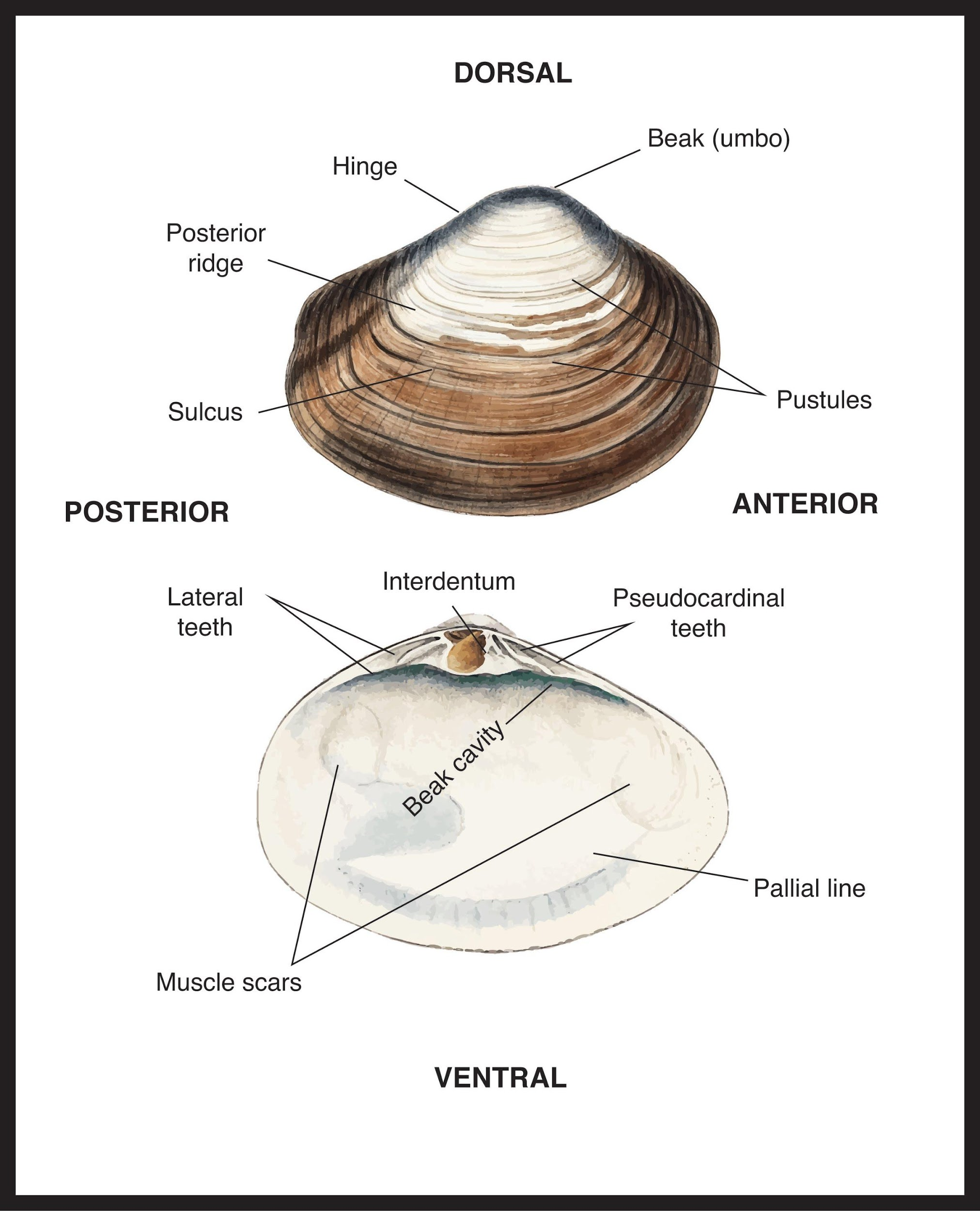
The two halves of Unio are hinged
(a) Dorsally
(b) Ventrally
(c) Anteriorly
(d) Posteriorly
Answer
497.1k+ views
Hint: A bivalve shell is a part of the body that is the exoskeleton or shell of a bivalve mollusk. By definition, bivalves possess two shells or valves, a "right valve" and a "left valve", that are joined by a dorsal electric band called hinge ligament.
Complete step by step answer:
The shell of the bivalve class of mollusks is composed of two hinged parts or valves. In all essentially aquatic locales, bivalves are very common, including saltwater, brackish water, and freshwater. The shells of bivalves are commonly seen washed up on beaches (often as separate valves) and along the edges of lakes, rivers, and streams. With the help of a structure called “teeth,” the two valves usually articulate with one another which is situated along the hinge line. The two valves in many bivalve shells are symmetrical along the hinge line. When they are found truly symmetrical, such an animal is said to be equivalved; if the valves vary from each other in size or shape, inequivalved and, the valves are said to be equilateral if symmetrical front-to-back and are otherwise considered inequilateral.

So, the correct answer is, ‘dorsally.’
Additional information:
1) The bivalve shells of the bivalve mollusk are composed of two calcareous valves. They are the mantle which is a thin membrane surrounding the body, secretes the shell valves, ligament, and hinge teeth. And the other one is the mantle lobes that secrete the valves, and the mantle crest creates the other parts.
2) The hinge teeth are generally conservative within major groups and have historically provided a convenient means upon which to base classification schemes and the phylogenetic order. Some of the various hinge tooth arrangements are Taxodont, Dysodont, Isodont, Heterodont, Asthenodont, Anodont.
3) Unlike that of gastropods, the bivalve foot does not have a flat creeping sole but is bladelike (laterally compressed) and pointed for digging. Their muscles mainly responsible for the movement of the foot are the anterior and posterior pedal retractors.
4) These bivalve shells have many uses which are trading in international trade in bivalves and their shells. These uses include Aesthetic{Jewellery, in particular, nacre (mother of pearl) , high-quality Go stones}; Raw material(Chalk, Glue, Varnish) ; Food.
5) As greenshell mussel, a supplement that is used against inflammation-associated arthritis in humans and animals, though a 2006 review suggested a lack of compelling evidence in human cases.
Note: Professional and amateur conchologists collected the bivalve shells and are sometimes harvested for commercial sale in the international shell trade or for use in glue, chalk, or varnish, occasionally to the detriment of the local ecology.
Complete step by step answer:
The shell of the bivalve class of mollusks is composed of two hinged parts or valves. In all essentially aquatic locales, bivalves are very common, including saltwater, brackish water, and freshwater. The shells of bivalves are commonly seen washed up on beaches (often as separate valves) and along the edges of lakes, rivers, and streams. With the help of a structure called “teeth,” the two valves usually articulate with one another which is situated along the hinge line. The two valves in many bivalve shells are symmetrical along the hinge line. When they are found truly symmetrical, such an animal is said to be equivalved; if the valves vary from each other in size or shape, inequivalved and, the valves are said to be equilateral if symmetrical front-to-back and are otherwise considered inequilateral.

So, the correct answer is, ‘dorsally.’
Additional information:
1) The bivalve shells of the bivalve mollusk are composed of two calcareous valves. They are the mantle which is a thin membrane surrounding the body, secretes the shell valves, ligament, and hinge teeth. And the other one is the mantle lobes that secrete the valves, and the mantle crest creates the other parts.
2) The hinge teeth are generally conservative within major groups and have historically provided a convenient means upon which to base classification schemes and the phylogenetic order. Some of the various hinge tooth arrangements are Taxodont, Dysodont, Isodont, Heterodont, Asthenodont, Anodont.
3) Unlike that of gastropods, the bivalve foot does not have a flat creeping sole but is bladelike (laterally compressed) and pointed for digging. Their muscles mainly responsible for the movement of the foot are the anterior and posterior pedal retractors.
4) These bivalve shells have many uses which are trading in international trade in bivalves and their shells. These uses include Aesthetic{Jewellery, in particular, nacre (mother of pearl) , high-quality Go stones}; Raw material(Chalk, Glue, Varnish) ; Food.
5) As greenshell mussel, a supplement that is used against inflammation-associated arthritis in humans and animals, though a 2006 review suggested a lack of compelling evidence in human cases.
Note: Professional and amateur conchologists collected the bivalve shells and are sometimes harvested for commercial sale in the international shell trade or for use in glue, chalk, or varnish, occasionally to the detriment of the local ecology.
Recently Updated Pages
Master Class 11 Economics: Engaging Questions & Answers for Success

Master Class 11 Business Studies: Engaging Questions & Answers for Success

Master Class 11 Accountancy: Engaging Questions & Answers for Success

Master Class 11 English: Engaging Questions & Answers for Success

Master Class 11 Computer Science: Engaging Questions & Answers for Success

Master Class 11 Maths: Engaging Questions & Answers for Success

Trending doubts
Which one is a true fish A Jellyfish B Starfish C Dogfish class 11 biology CBSE

State and prove Bernoullis theorem class 11 physics CBSE

1 ton equals to A 100 kg B 1000 kg C 10 kg D 10000 class 11 physics CBSE

In which part of the body the blood is purified oxygenation class 11 biology CBSE

One Metric ton is equal to kg A 10000 B 1000 C 100 class 11 physics CBSE

Difference Between Prokaryotic Cells and Eukaryotic Cells




